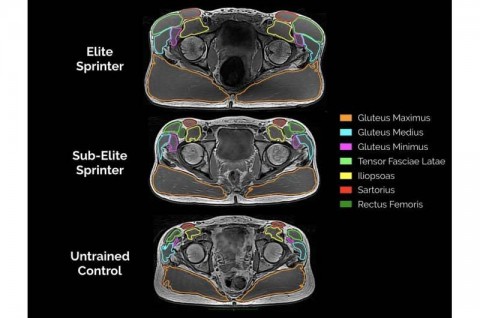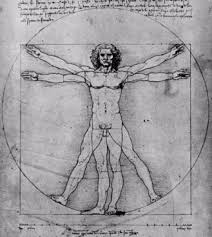There seems to be a school of thought when it comes to resistance training that you're either training for performance or for aesthetics. It's either bodybuilding or strength and conditiong. Built for show or for go. It was as though the two goals were mutually exclusive and could not overlap. Meatheads would mock those who couldn't build 20 inch arms. And athletes would point out all the gym rats that trip over their own feet during a game of football. But is that the case? If you train for hypertrophy i.e. size, does that mean you'll be useless on the playing field? New research says that's not the case. The study look at muscle volume and strength and compared this among three groups 1) elite sprinters n= 5, 2) sub-elite sprinters n= 26, and untrained controls n=11. All study subjects were male. Elite sprinters were defined as though that could run a 10.10 second 100 meter and sub-elite as though that could run the 100 m in 10.80 seconds. To put in perspective how fast a 10.10 second 100 metre is, only four Canadians have ever run a sub 10 second 100 m including Olympic champion Donovan Bailey and Olympic bronze medallist Andre De Grasse. The study subjects underwent MRIs to determine muscle volume of 23 lower limb muscles and 5 functional muscles. These were then correlated to 100 m times and isometric strength. What they found was that the muscularity of elite sprinters was greater in elite sprinters than sub-elite and both were greater than the controls. In particular the hip extensors showed the biggest difference among the groups and this accounted for 31-48% of the variability in 100 m times. Of the hip extensors it turns out the gluteus maximus alone accounted for 34-44 % of variance in 100...
Corrective Exercise Gone Bad
- Chris Collins
- Training
- 2403 Hits
- 29 Comments
-
Did you ever watch those tv specials 'When Animals Go Bad'?You know the ones I mean? They show video footage of a normally docile and affectionate pet or animal that just snaps and some poor unsuspecting soul pays the price for it?I remember seeing an animal handler have a koala bear freak out at Busch Gardens in Tampa once. The little kids that were so curious to see this cute bear all rushed the handler and surrounded him quickly.And if you can imagine to a koala bear seeing all these little monsters running at it and screaming the koala bear thinks it's getting attacked.So the koala starts clawing at the handler to get away. The bear doesn't want to be held by the handler while all these little people are charging forward.And up until that point I never realized that koalas have sharp claws. But after seeing the handler get sliced and diced by the koala I don't think of these animals as cute and cuddly anymore.Long story short the koala ended up back in its habitat. And the handler was taken away on a stretcher for stitches and medical treatment.So what the heck does this have to do with training and fitness?Well just like at the zoo sometimes we have different intentions of the final outcome.In this case the koala bear, the handler and the little kids all hoped things would have turned out a little differently.The handler probably didn't forsee a trip to the hospital for stitches and maybe a shot.The bear didn't forsee what it perceived as an apparent attack.And the little kids didn't realize they wouldn't be able to pet the bear and were a little distraught to see the bear attack the handler and be wisked away shortly after still snarling and trying to defend itself.Now back to the gym.Imagine...
Lessons Learned from Mike Robertson - Part II
- Chris Collins
- Training
- 1964 Hits
- 0 Comments
-
In the last post I introduced a discussion about body awareness. And what I meant by this was understanding which muscles were firing, when they are firing and how they are firing. The reason this is so important is that many of us having compensations or deficiencies of some type. Think about it. The aches and pains that we get from time to time are partly due to the strain we put our body under when it is out of alignment. And when we live with these aches and pains for long enough we can sometimes become a little bit desensitized to the feedback our body is trying to give us. For example if you've had a chronic low back problem you may not think about it all the time. But if someone asks you how it is and you stop and think about it for a second you'll realize it simply hasn't corrected itself but instead you learned to block it out somewhat in order to get through the day. And you aren't consciously thinking about it until someone asks you about it or it gets worse. So let's jump ahead and assume that someone was able to point out where it is that you're out of alignment and how to correct this alignment issue. Perhaps it's a lack of frontal plane (think side to side) glute activity and by firing this muscle helps to restore your alignment and take stress off your joints that were 'picking up the slack'. As well, you were also made aware of how you will alter your body position to cheat when your glutes get tired and you don't want them to work anymore.This would all be very useful info to you. So how do you make sure to ingrain this process and ensure...
5 Tips for Better Step-Ups
- Chris Collins
- Training
- 2002 Hits
- 1 Comment
-
Today we're celebrating Thanksgiving weekend in Canada. So with the indulgence in turkey, gravy, potatoes and of course some pumpkin pie the mind tends to shift towards thinking about ways to burn all these extra calories. Plus as the seasons change our activities move from links and lakes to the hills for winter fun.So with this in mind I usually like to incorporate more step-ups in the workout. Step-ups are great in that they work well for all levels, they allow you to get in some quality single leg work and with a few changes in the acute variables of sets, reps and rest you can train for a variety of different purposes.But before you jump in and start with the step-ups there are 5 technique points that will help you perform this lift more safely and effectively.1. Maintain a neutral foot. Many of us tend to roll into pronation when we bend at the ankle-knee-hip. Imagine your foot collapsing towards the arch when you take a step. If this happens you will disrupt the chain reaction that occurs with ground based motion and have altered mechanics as you step up. Keep a neutral foot and watch that the knee is in line with the 2nd/3rd toes.2. Paw the bench. With the foot that is on the bench imagine pulling the bench towards yourself. This loads up the glutes and hamstrings which many of us have difficulty recruiting during our leg training. 3. Take a larger step. This ties in with the previous point of trying to engage the posterior chain. Many of us are quad dominant and look to use our quads first and glutes and hamstrings, second, if at all. With a larger step you open up the angle at the knee and hip which takes load off the...

